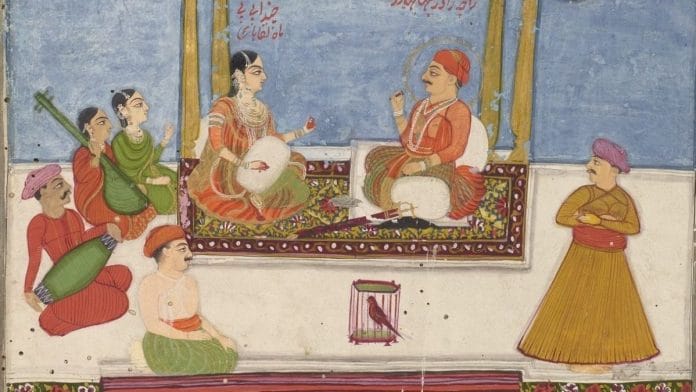Many factors played a part in the glorious legacy of Nizam Ali Khan, Asaf Jah II — the second Nizam of Hyderabad — whose reign is considered one of the longest and most successful of the Nizams. But his secret weapon was a woman who could wield a bow and javelin just as expertly as pen and ink. Mah Laqa Bai — the ‘visage of the moon’ — was his trusted ‘omarah’, the highest-ranking noble from whom the rulers of the state regularly sought advice. She was the original inspiration behind the first Urdu novel Umrao Jaan Ada.
Mah Laqa Bai was an iconic figure in Indian history whose life cannot be easily defined or boxed. She was a poet, singer, dancer, courtesan, philanthropist, a champion of girls’ education, warrior and political adviser — all at once.
In 1798, she became the first woman to compile and calligraph her anthology (diwan) of poems (ghazals) in the Indian subcontinent, named ‘Diwan e Chanda’, a manuscript collection of her 125 Ghazals. The collection of 39 ghazals with 5 couplets in each, named after her ‘Gulzar-e-Mahlaqa.’ was published in 1824, posthumously. In ‘Gul ke hone ki tawaqqo pe jiye baithi hai‘ she writes of the anticipation and fear of change:
Gul ke hone ki tawaqqo pe jiye baithi hai
Har kalī jaan ko mutthi mein liye baithi hai
Kabhi sayyad ka kahta hai kabhi khauf-e-khizan
Bulbul ab jaan hatheli pe liye baithi hai
[Hoping to blossom (one day) into a flower,
Every bud sits, holding its soul in its fist.
Between the fear of the fowler and the approaching autumn,
The bulbul’s life hangs by a thread]
In the late Mughal period, Mah Laqa Bai excelled at singing love songs with the Deccani form of Kathak dance, which was popular and practised by courtesans.
She is remembered as a progressive woman who lived on her own terms during a time when it was exceedingly difficult for women to shed their traditional gender roles.
“One has to look closely at the century she lived in, when it was simply unimaginable for a woman to even step out of purdah. Their roles were to be daughters, wives and mothers. It’s incredible that such a time produced a woman like this,” danseuse Manjari Chaturvedi told Firstpost.
In his historical novel Husn Ka Daku, author Abdul Halim Sharar presented the character of Mah Laqa as a woman who benefits from the modern education system. “When she was released from school education, she was handed over to Miss Minton who was an active and intelligent lady. She became so vigilant and spoke English so fluently that even college-going man couldn’t compete with her,” he wrote.
Also Read: Anandi Gopal Joshi — the first Indian woman to study western medicine, sponsored by Tilak
Mah Laqa — ‘visage of the moon’
Mah Laqa Bai was born on 7 April 1768 in Aurangabad in present-day Maharashtra as Chanda Bibi to courtesan Raj Kanwar Bai and Nawab Basalat Khan Bahadur, a mansabdar (military official) at Mughal emperor Muhammad Shah’s court.
According to Maha Laqa’s biography, her mother Raj Kanwar Bai moved from Rajputana to Aurangabad, the Nizam’s capital at the time, when she met and married Khan who had migrated from Delhi to Hyderabad. Chanda Bibi was adopted by Kanwar’s childless sister Mehtaab Ma who was the consort of Nawab Rukn-ud-Daula, a prime minister of the Nizam of Hyderabad. There she received the patronage of Nawab Rukn-ud-Daula who provided her with the best teachers and training. She was given her own library. At the age of 14, she became proficient in horse riding and archery. Her education was quite unusual for a woman of her time.
When she showed an inclination toward learning music and poetry, she was tutored by Kushal Khan Kalawant, the grandson of the revered musician Tansen, one of the nine gems of Akbar’s court.
Mah Laqa was a devout woman whose poems reflected the Sufi impact on her life, as she was an ardent believer in Sufi saint Hazrat Ali. When Mah Laqa died in 1824, she was buried next to her mother’s tomb that she constructed at the base of Maula Ali hill.
The title of ‘Mah Laqa Bai’ or ‘madame moon-cheek’ was bestowed on her by Mir Nizam Ali Khan because of her charisma and abilities.
Also Read: Dinesh Nandini Dalmia — Nehru’s ‘mysterious one’, a Hindi writer and a feminist icon
‘Omarah’, warrior, advisor to the Nizam
Mah Laqa Bai was an unmarried woman in a male-dominated court who accompanied Nizam II in three wars — Battle of Kolar in 1781, Battle of Nirmal in 1782 and Battle of Pangal in 1789. Disguised in masculine garb, she was a warrior renowned for her skills on the battlefield.
Mah Laqa was also an expert in the art of diplomacy and matters of state policy, which made her the confidante of two successive Nizams (II and III). She was the only woman in Hyderabad to receive such public prominence at the time. After being elevated to the rank of ‘omarah’, Mah Laqa was given land rights, honorary guards, a noble’s palanquin, and drummers to announce her arrival.
She was a philanthropist too and is said to have contributed about one crore rupees at the time to educate girls. She bequeathed her fortune to homeless women at the time of her death. A portion of her jagir (land) was also granted to Osmania University, which still exists today.
Scott Kugle, in his book, When Sun meets Moon, writes, “Mah Laqa Bai fascinated me because of her multi-dimensional personality and her unique position in the Deccan history… For a courtesan to be able to exercise such powers was unthinkable and placed her in a unique position.”
(Edited by Srinjoy Dey)






